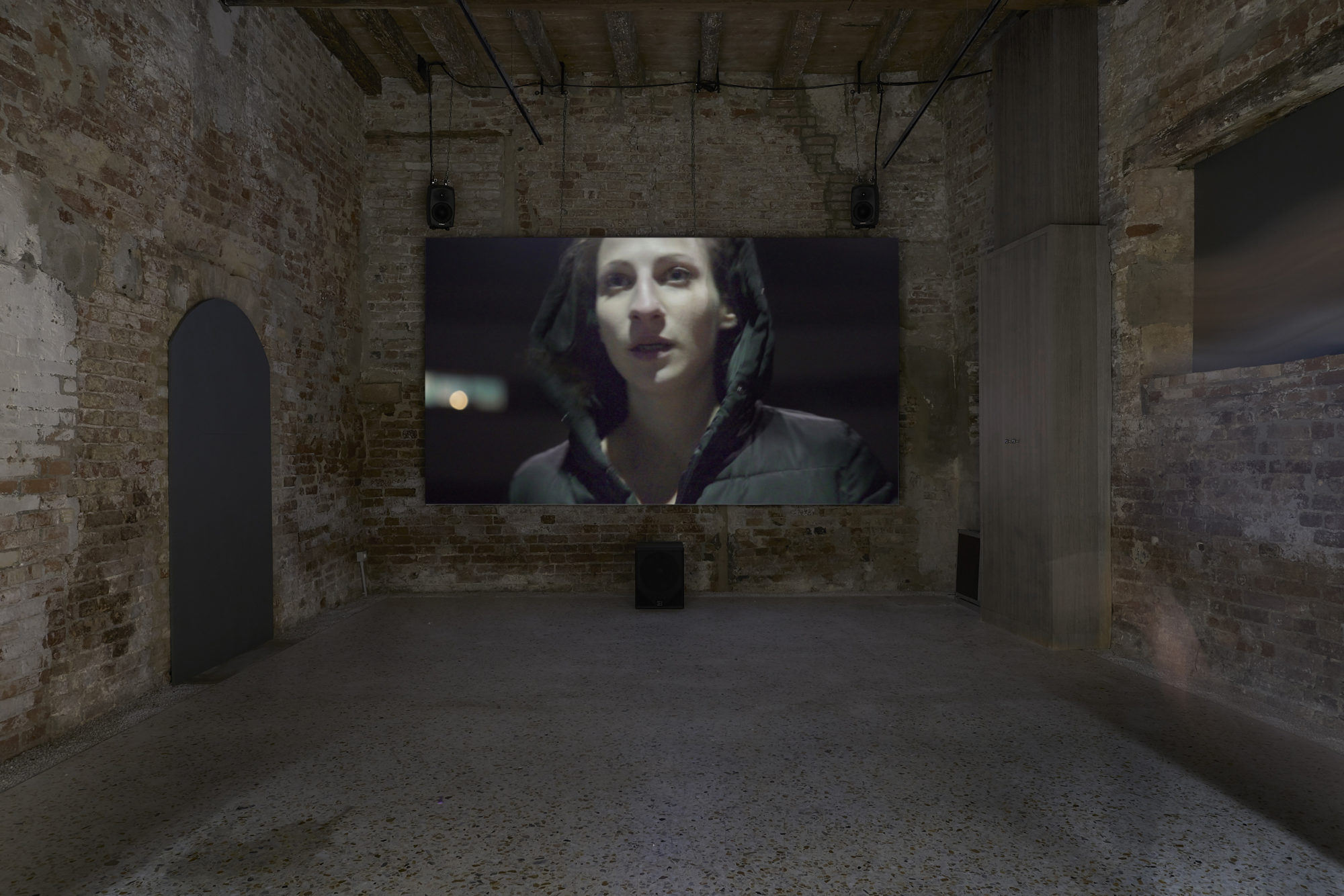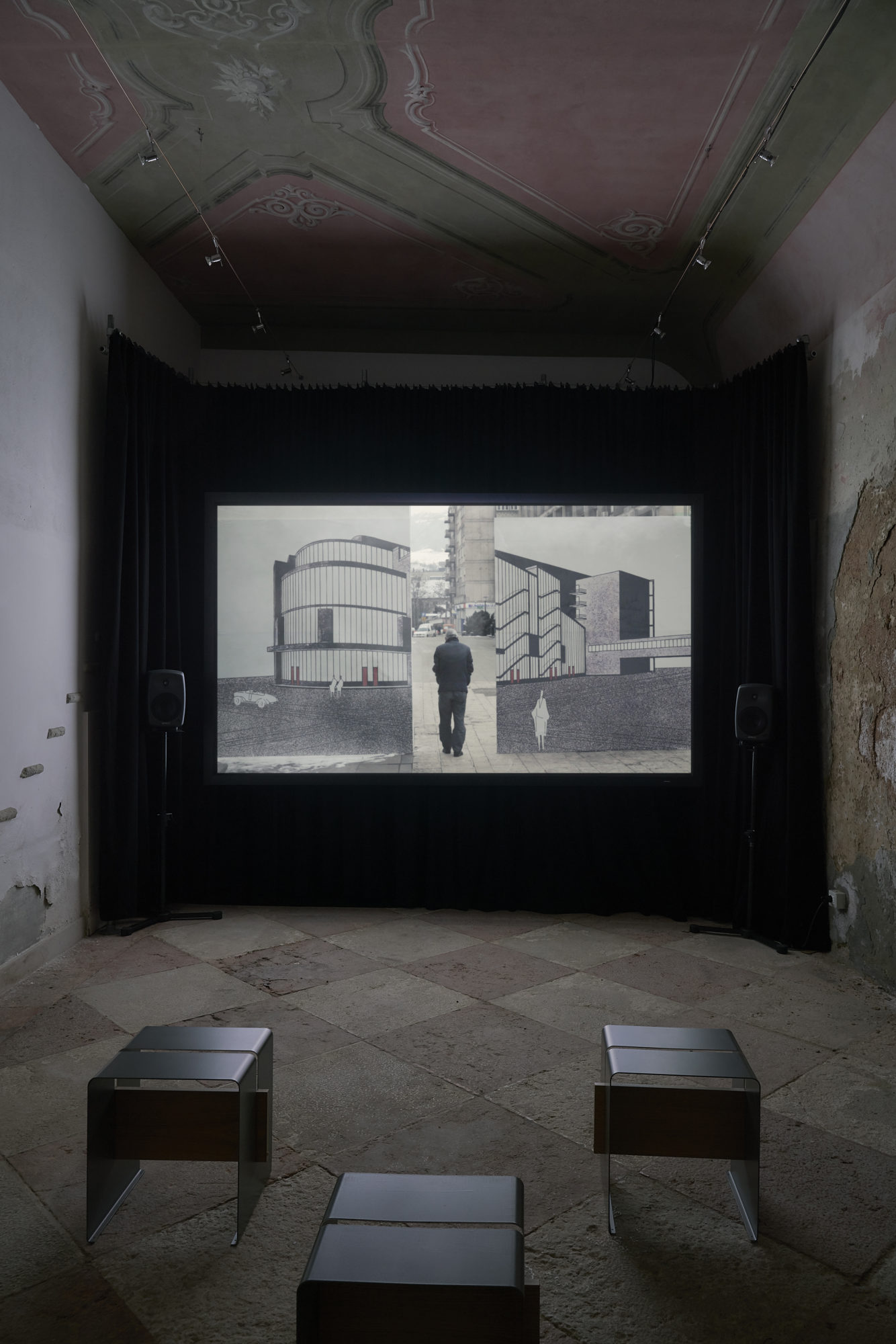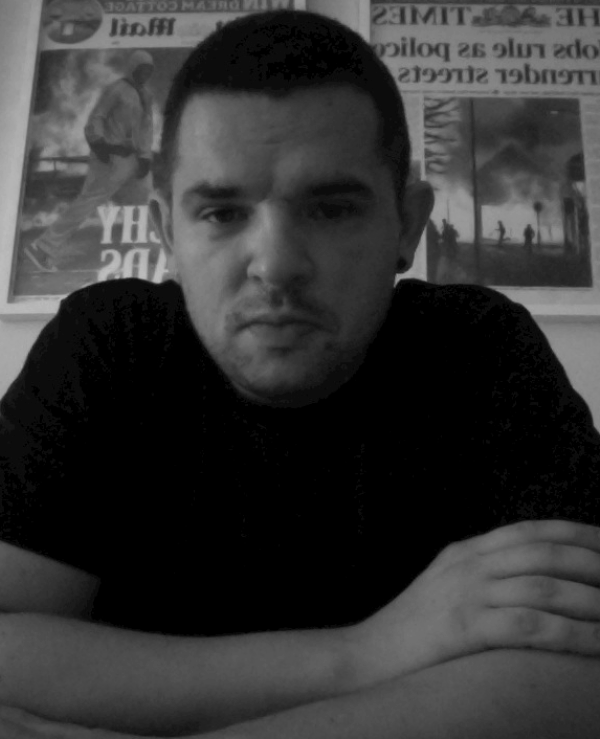Heart, Hands, and a Shovel: Danica Dakić’s Zenica Trilogy (Pavilion of Bosnia and Herzegovina; Uroš Čvoro)
Reflecting on the national pavilion of Bosnia and Herzegovina (BiH) in the context of a Venice Biennale titled “May You Live In Interesting Times”, it is impossible to not think of a BiH joke-curse from the 1990s: “May you see your house on CNN.” This joke captures the paradox of global visibility that accompanies regions that have been subject to conflict and crisis.(On art that uses humour to respond to crisis, see Uroš Čvoro and Chrisoula Lionis, “When the Periphery Laughs: Humor and Locality in Contemporary Art from Greece and Bosnia and Herzegovina,” Cultural Politics15:2 (2019), 223-243. ) Seeing your house in BiH on CNN during the nineties was possible only if it had become the site of destruction or violence. In this context, the artist representing BiH on an international stage takes on what can be described as a geopolitical burden: they are charged with the responsibility to ethnographically narrate the local experience and translate it into the global artworld lingua franca.(I borrow the term ‘geopolitical burden’ from artist Vladimir Nikolić. See Nikolić, ‘About Death Anniversary 1968–2004’ (2007), 24, http://www.vladimir-Nikolić.com/foto/about%20death%20anniversary.pdf(accessed 9 September 2019).)
And this burden is made even more complex by the fact that for over two decades, BiH has been seen as a readymade post-conflict society plagued by rampant nationalism, political nepotism and corruption, social decay, and mass migration out of the country.While Zenica Trilogy implicitly deals with these questions, Danica Dakić avoids playing into the post-conflict spectacle by questioning the present of BiH as a foregone historical condition, and tracing class consciousness through lived, built and aesthetic forms of expression in the city of Zenica in Central Bosnia.(Zenica was one of main industrial centres of production in BiH, and at the core of socialist working-class subjectivity in Yugoslavia.) Zenica Trilogy consists of three videos that narrate the transitional history of the city of Zenica through key subjects of socialism: women, the (physical and cultural) worker, and the young.The protagonists of the three videos perform their own lives and experience of BiH in transition.(On delegated performance, see Claire Bishop, “Delegated Performance: Outsourcing Authenticity,” October 140 (2012), 91.)
But they are also performing the collective bodies around which the socialist ideology in Yugoslavia structured itself, and the way in which that ideology changed over the last three decades. Before the background of transformation of the collective body of socialism into post-socialist “individualism,” Zenica Trilogy captures different forms of collectivity, from the socialist ideal of hard work (in udarnik workers) to impressionable and corruptible youths, to intellectual workers.(On the transformation of subjects of socialism, see Renata Salecl, The Spoils Of Freedom:Psychoanalysis, Feminism and Ideology after the Fall of Socialism(London: Routledge, 1994), 44–7.) The first video, Zgrada(The Building), takes the form of an essay film about the history of the Bosnian National Theater in Zenica. The work is narrated through the perspective of Zoran, a long-time employee of the theatre whose personal history is interwoven with the institution.
Taking Walter Gropius’ principle of “total theater” as the departure point, Dakić highlights the building as a living being through extended shots of the rotating stage floor, and through close-up shots of leaking water and decay. These are juxtaposed with the narrator giving details about his personal life and his connection to the building. The narrator, like the building, finds himself in an incomprehensible new age; one in which the collectivity once inherent in the experience of theater has been lost; and one where mass unemployment, pollution, and exploitation have become the norm. This is powerfully illustrated through a reference to the destruction of the Zenica steelworks—which went from employing tens of thousands of people to barely two thousand—and to the fate of the neglected and deteriorating modernist sculpture by Yugoslav sculptor Dušan Džamonja. Located at the front of the Zenica theater, the rusted metal of the sculpture becomes a stand-in for the forgotten history of modernist sculpture and monuments in Yugoslavia. But as much as the film is about the perception of this history “from the outside”, it juxtaposes this perception with a local understanding of modernism “from the periphery”. When asked about “total theater”, the narrator answers: “That is something they maybe do in the West”. The unrealised ideal of Gropius’ total theater, which served as in inspiration for the Zenica building, has been forgotten.

Danica Dakić. Zenica Trilogy. Installation view, 2019. Image courtesy of the author. Photograph by Egbert Trogemann © VG Bild-Kunst Bonn
Shot as an 18-minute loop on the moving stage of Zenica theatre, the second film, Scena (The Stage) features a young woman running.
The sound of heavy breathing from the video permeates the whole pavilion, creating the effect of a living space. In effect, it operates as the voice of the pavilion, echoing the interest in the humanist dimension of architecture we can already observe in Zgrada. The image and the sound of running recall works such as Jennifer Allora and Guillermo Calzadilla’s Tank Treadmill that was shown in Venice in 2011. But unlike that work, Scenais presented as a video loop of a person running in one spot, conjuring up sensations of helplessness and desperation. It is a powerful metaphor for the spatial and temporal immobility that has become intrinsic to lived experience inside BiH. The war in BiH, in addition to the physical devastation of life and property, can be understood as a rupture in the experience of time.

Danica Dakić. Čistač (The Cleaner), Installation view, 2019. Image courtesy of the author. Photograph by Egbert Trogemann © VG Bild-Kunst Bonn
Much has been written about lost or “dead” time in war, about pre-war “normality” as opposed to post-war pathology, and about the feeling of being stuck in “Bosnian meantime”.(On Bosnian ‘meantime’, see Stef Jansen, Yearnings in the Meantime: ‘Normal Lives’ and the State in a Sarajevo Apartment Complex(New York: Berghahn2015), 457.) For older generations, such as the narrator of Zgrada, this expression refers to the loss of historical experience through the destruction and negation of the social and cultural tissues associated with Yugoslav socialism. For younger generations (such as the runner in Scena), on the other hand, it refers to the desire to escape BiH in search of a better life. Indeed the last two decades have witnessed the migration of tens of thousands of young people out of the country, creating a generation of precarious migrant workers in the EU, whose voice and experience have not been heard. Dakić’s own position as a Sarajevo-born artist who has lived outside of BiH for over three decades operates as a connecting tissue between these two experiences.(Exodus of BiH artists is a significant cultural phenomenon with a long history, but here it relates to a still-developing cultural expression of a younger generation.) Čistač (The Cleaner), the third film, is a short documentary about two brothers who represent different forms of “cleaning” in relation to the urban space of Zenica. Adil is a 1990s war refugee who moved to Zenica as a consequence of ethnic cleansing during the war. We find him in a hospital bed, undergoing dialysis. Adil has been connected to the dialysis machine for so long that he has learned how to live with it. He has become a virtuoso at managing his own health and an activist successfully advocating for a new law on organ donations. He tells us about his brother, who has been voluntarily cleaning the parks and streets of Zenica every day for over twenty years. In their own way, both brothers keep up a personal utopia despite the realities of the post-war period. Shots of Adil, his brother, and smoke-spewing chimneys in Zenica are juxtaposed with the dialysis machine as an instrument of cleaning and industrial pollution in Zenica.
The question of the cultural, social and political role of build spaces that underpins Dakić’s investigation of the relations between socialism and modernism places Zenica Trilogy at the center of current debates regarding the legacy of Cold War modernism. For the post-1989 transition to neoliberalism has framed the former Easter Bloc as a site of totalitarianism that needs to be overcome. This includes subsuming the expressive abstract architectural forms of the former Yugoslavia—reminiscent of their international contemporaries, yet ignored by the Western art historical canon until very recently—under the narrative of Cold War modernism. The increased global visibility of Yugoslav built spaces in exhibitions, publications, music videos, documentaries, and on social networks has been inscribed into the Cold War ideological framework as the “lost”, “otherworldly”, or “vanishing” material remnants of totalitarianism.(On Yugoslav monuments as remnants of totalitarianism, see Andrew Herscher “From the Politics of Memory to the Memory of Politics: The Socialist Monument In and After Yugoslavia”. Unpubl. paper presented at conference Memorial For(u)ms –Histories of Possibility, July 3-4 2015, Berlin.)
 Danica Dakić. Scena (The Stage), Installation view, 2019. Image courtesy of the author. Photograph by Egbert Trogemann © VG Bild-Kunst Bonn
Danica Dakić. Scena (The Stage), Installation view, 2019. Image courtesy of the author. Photograph by Egbert Trogemann © VG Bild-Kunst Bonn
Dakić’s intervention questions the narrative that has viewed places such BiH through the prism of belated modernization. In this sense, Dakić’s exploration of the legacies of build spaces in Socialist Yugoslavia thematically compliments Igor Grubić’s exhibition Traces of Disappearing (In Three Acts) in the Croatian Pavilion (see Sven Spieker’s article in this series). However, Dakić does not simply trade in socialist nostalgia. In looking at the legacy of class consciousness and socialist modernism, she rather traces their relationship with socialist mythology. This is most clearly evident in her exhibition, as part of the pavilion, of a gilded shovel (Sirotanovićka), a reference to shock worker Alija Sirotanović, a miner who in 1947 set a record in the amount of coal extraction in a single day. Sirotanovićwas one of central points of socialist ideology and mythology, and Zenica Trilogyuses the the gilded shovel to transform Sirotanović’s physical labour into a cultural commodity, and local specificity into abstracted visibility.
The inclusion of the gilded shovel also connects Zenica Trilogy with the contemporary mediation of socialism through popular culture. While this is implicit rather than explicit in the work,(The pavilion’s Instagram account makes a reference to the appearance of Alija on a Dinar note.) to generations of children of socialism images and stories about Zenica, Alija and the shovel are inseparable from the music of the iconic Sarajevo rock band Zabranjeno Pušenje (such as the song from which this response borrowed its title). Much like the modernism discussed in Zenica Trilogy, popular music in Yugoslavia was located between a divergent and often contradictory network of influences: between the historical roots in the Eastern tradition (Ottoman and Byzantine) and Westward leanings; between socialist ideals and market-driven practices; between the aesthetics of socialist realism and Western postmodernism. This popular culture survived the death of Yugoslavia and continues to be one of main forms of cultural memory.
Zenica Trilogy is a significant contribution to a growing body of contemporary work investigating the historical and cultural legacy of Yugoslavia in the present.(The question of the cultural legacy of Yugoslavia in the context of contemporary BiH is a complex one. Because of its multicultural make-up as well as its current political fragility, BiH is often seen as “mini Yugoslavia”. On the one hand, this has been used as an excuse for attempts at further fragmentation and division along ethnonationalist lines. However, on the other hand, BiH cultural identity in art, music, and architecture did see its creative peak in Yugoslavia during 1970s and 80s. I address the legacy of Yugoslavia in contemporary art in my book Transitional Aesthetics: Contemporary Art at the Edge of Europe. (London: Bloomsbury 2018).)The work recalls Yugoslavia’s socialist modernism as a contradictory yet nevertheless emancipatory utopian project: a society that empowered workers, women and youth to experience themselves as part of a global collective. Dakić juxtaposes the lived experiences of these groups against the present in which they have been disenfranchised. Workers have become a disempowered precariat; women and unemployed youth have become marginal social minorities burdening the economy; and culture has been sidelined.Dakić leaves us with a lingering question of the utopian possibilities implicit in today’s imagination. Is it even possible to imagine an udarnik today? Is it the perpetually running figure from the Stagevideo with its reference to the precarious and ruthless working conditions of the present? Or is it the narrator from Zgrada whose understanding of the world is slowly fading away like the building that was once part of his life? Or, finally, is it the worker from Cleaner, a representative of the vanishing traditional working class?
While Zenica Trilogy does not provide us with answers, if viewed in the context of the world of today (and in the context of the 2019 Biennale), the contemporary shock worker may well be the perpetually-blood-mopping robotic arm from Sun Yuan and Peng Yu’s work Can’t Help Myself, which is currently shown at the Arsenale as part of the Biennale.Featuring a large motion-sensor guided robotic arm performing the task of keeping a blood-like red liquid in one area of a large glass cube, Can’t Help Myself’s popularity with Biennale audiences can be explained by the satisfaction we derive from watching a “job well-done”, or the fascination with a machine controlling a volatile situation. In the context of the questions posed by Zenica Trilogy, this popularity can also be understood as a kind of attraction to the spectacle of the 21stcentury shock worker sweeping away the stain of the working class from the public’s view.
Articles in this special issue:
[su_menu name=”Venice Biennale”]




